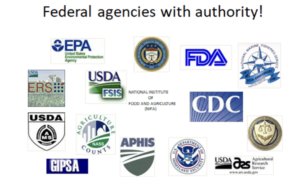Rural America is America’s breadbasket – it provides the foundation for the US food system and our important food exports. Many who reap the benefits of rural American work have no idea about the source of their food or the steps taken to keep it safe. Interviews with kids in urban centers often result in comments like: “My potatoes come from a box.”
Raising plants and animals for food is one of America’s largest industries. Usually, US food exports rank first or second in overall US exports, and these sales also help the US national balance of payments.
However, no food is nutritious unless it is safe to eat. When eating food makes us ill, valuable nutrition from that food cannot be retained. Understanding why and how food can become unsafe is important in preventing food from deteriorating, but, first, I believe it may be beneficial to understand the incentives and rules in place that keep our food safe. This is another aspect of our country’s food production process that many Americans do not understand (including some senior-level government officials). In fact, a nominee for commissioner of the US Food and Drug Administration (FDA) once asked me what the food company I worked at had to do with the FDA!
America has strived for safe and healthy food since its inception. As a result, our current system for ensuring food safety is complex. The first step begins with farmers, ranchers, and processors. As growers, they do their best to produce food without contaminants that can lead to bacteria, viruses, and disease. Departments and agencies also play a vital role.
Who are these departments and agencies? Many consumers know the Food, Drug, and Cosmetics Act (FDCA) and the Food and Drug Administration – located within the US Health and Human Services Department that implements it.

There were, however, prior food safety efforts within the US Department of Agriculture (USDA) dating back to the department’s formation in 1862. The Food Safety and Inspection Service (FSIS) was formed shortly after the novel The Jungle by Upton Sinclair was published in 1906. That novel sparked public outrage at unsanitary meat slaughtering and packing practices. Poultry was later added later to FSIS authority for oversight and inspection.
Sinclair’s work jump-started a movement toward furthering food safety; the Federal Meat Inspection Act and the Pure Food and Drug Act became law on the same day in 1906. Enforcement of the laws was assigned to the Department of Agriculture, wherein the eventual FDA resided until 1940. The FSIS (within the food safety mission area at the USDA) implements the meat, poultry, and egg safety acts to this day, while the FDA oversees all other food products as well as drugs and cosmetics.
There are other federal departments that have authority to enforce and research food safety regulations – see the illustration below outlining all the food safety regulatory and research agencies in the United States. States, cities, counties, and towns also have food safety agencies that oversee local food production (including restaurant oversight) in their respective jurisdictions. Certainly, our food safety system is complex and (some would say) difficult to understand; however, attempts at reform have been heavily resisted.
The National Air and Space Agency’s need to send safe food into space inspired the development of new production and processing systems. These systems were called Hazard Analysis and Critical Control Point (HACCP) systems.
Initially, there were only voluntary systems, but, after children died from outbreaks of unsafe food, Congress suggested that US meat and poultry companies also implement these systems. The Pathogen Reduction and Hazardous Control regulation was issued under the authorities of the meat and poultry acts and was implemented by the FSIS over a three-year period in the late 1990’s.
The FDA also received authorization to implement the Food Safety Modernization Act (FSMA). As far back as 1998, the FDA issued guidance about minimizing microbial contaminants in fresh fruit and vegetables. While implementing the FDA’s guidance is voluntary, the introduction of Good Agricultural Practices (GAP) gave useful information to growers. The FSMA also had compliance programs for companies, which contained guidelines and tools to reduce hazards and the risk of foodborne illness in products made from fresh fruits and vegetables and all other commodities.
Since then, the FDA and USDA have coordinated standard Good Agricultural Practices, which can serve as requirements for a company to be allowed to export products.
Rural America provides the foundation for the US food system and also produces our important food exports. Learning about our food safety system (its history, structure, and procedures) is important for all of us to be able to enjoy a safe, nutritious, and delicious diet.
